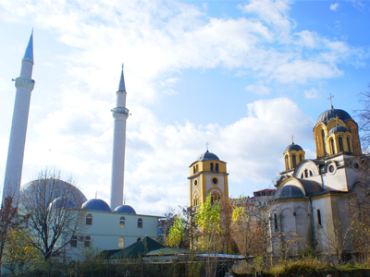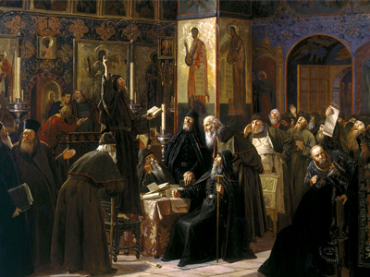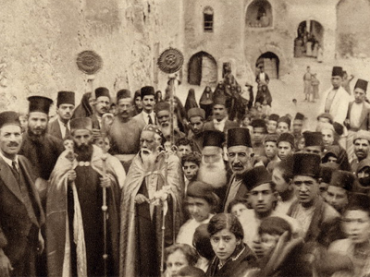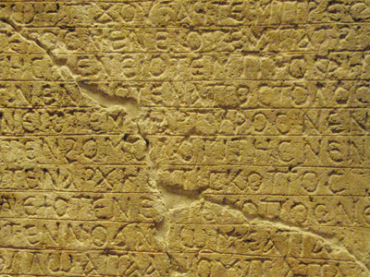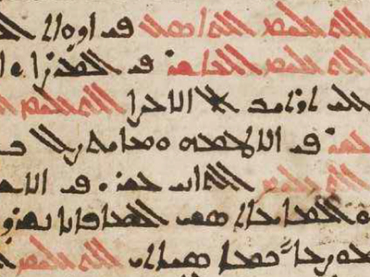Syriac and Eastern Christianity
Syriac Grammar
With Bibliography, Chrestomathy, and Glossary
By Eberhard Nestle; Translated by R. S. Kennedy
Series: Syriac Studies Library 91
ISBN: 978-1-61719-182-4
Grammar of Syriac, prepared by the celebrated editor of the New Testament, with bibliography of nineteenth-century works on Syriac, three Syriac texts, and glossary.
$157.00
Colloquial Syriac
As Spoken by the Assyrian Levies
Compiled by Lieutenant R. Hart
Series: Syriac Studies Library 92
ISBN: 978-1-61719-184-8
Guide, grammar, and phrasebook of Eastern Syriac as spoken by the native populace, written for officers in the British Mandate of Iraq so they could understand the language of the native military forces in the area.
$156.00
The Separation of the Monophysites
By W. A. Wigram
Series: Syriac Studies Library 93
ISBN: 978-1-61719-185-5
This is a history of the so-called "Monophysite" schism from the Council of Chalcedon to the Muslim conquest.
$141.00
The Palestinian Version of the Holy Scriptures
Edited and Translated by George Henry Gwilliam; In Collaboration With Ernest Nathaniel Bennett
Series: Analecta Gorgiana 528
ISBN: 978-1-61719-186-2
This work consists of five leaves of the old Syriac version of the Bible, in the Palestinian dialect. Included are images of some of the leaves, Syriac text, English translation, notes, and a essay on the underlying Greek text.
$46.00
Three Syriac Law codes
Richterliche Urteile des Patriarchen Chenanischo; Gesetzbuch des Patriachen Timotheos; Gesetzbuch des Patriachen Jesubarnun
Edited and Translated by Eduard Sachau
Series: Syriac Studies Library 95
ISBN: 978-1-61719-189-3
Three Syriac law codes issued by Syriac Patriarchs under Muslim rule; they include ecclesiastical and civil law with a German translation.
$178.00
The Utmost of Christian Calamities
The Oppression, Aggression, Abduction, Banishment, Slaughter, Captivity, and other Atrocities and Contempts of Christians in Mesopotamia and Mardin in Particular, in 1895 and 1914-1919
Series: Syriac Studies Library 96
ISBN: 978-1-61719-195-4
One of the well-known works of Syrian Catholic Priest Isaac Aramalet, originally published anonymously, this work is an account of the misfortunes suffered by Christians in the late 19th and early 20th centuries in Turkey (the Sayfo).
$212.00
Early Christian Mystics
Woodbrooke Studies 7
Edited and Translated by Alphonse Mingana
Series: Syriac Studies Library 97
ISBN: 978-1-61719-196-1
This volume contains the Syriac texts and annotated English translations of mystical treatises from five authors of the Church of the East belonging to the 7th and 8th centuries.
$194.00
La version syriaque de l’Octateuque de Clément
Traduite en français
Translation and Introduction by François Nau
Series: Syriac Studies Library 99
ISBN: 978-1-61719-200-5
François Nau (1864–1931) in this volume gives a French translation of the so-called Octateuch of Clement from Syriac, which has many parallels with other canonical literature such as the Apostolic Constitutions and the Canons of Hippolytus.
$161.00
The Book of the Priesthood
The First Homily on the Priesthood attributed to John Maron
Edited and Translated by Joseph Hubeika
Series: Syriac Studies Library 100
ISBN: 978-1-61719-201-2
Joseph Hubeika (1878-1944) here presents the Syriac text and Arabic translation of a long work on the priesthood attributed to Yuhanon Maron, but in fact from the hand of John of Dara.
$212.00
De S. Isaaci Ninivitae Vita, Scriptis et Doctrina
Accedunt Isaaci Tres Integri Sermones
Series: Syriac Studies Library 101
ISBN: 978-1-61719-202-9
In this volume, Chabot is concerned with the life and work of the widely influential Church of the East author Isaac of Nineveh (late 7th cent.). Three sermons, in Syriac and Latin, conclude the work.
$162.00
Étude sur les emprunts syriaques dans les parlers arabes du Liban
Series: Syriac Studies Library 102
ISBN: 978-1-61719-203-6
The present work, Michel Feghali’s doctoral dissertation, is the first large scale investigation of the survival of Syriac linguistic features in Arabic dialects; he examines in particular, the Lebanese dialects.
$117.00
L’école d’Édesse
By E.R. Hayes
Series: Syriac Studies Library 103
ISBN: 978-1-61719-204-3
In this work, the author’s doctoral thesis, Hayes looks at the “school” very broadly in general terms of the Christian intellectual and theological milieu of the city.
$194.00
Les lettres d’Afrahat le sage de la Perse
Étudiées au point de vue de l’histoire et de la doctrine
Series: Syriac Studies Library 104
ISBN: 978-1-61719-205-0
This volume, the author’s doctoral thesis, contains a detailed but concise study of Aphrahat’s Demonstrations. The main part of the book is divided into two parts: the Church in Persia, and doctrine in the Demonstrations.
$158.00
Syri Orientales, seu Chaldaei, Nestoriani et Romanorum Pontificum Primatus
Commentatio Historico-philologico-theologica
Series: Syriac Studies Library 105
ISBN: 978-1-61719-206-7
Khayyath, Chaldean archbishop of Amid, here explores the literary testimonies of writers in Syriac and Arabic from the Church of the East on the question of the primacy of the Roman pontiff.
$174.00
The Life and Works of Severus of Antioch in the Coptic and Copto-Arabic Tradition
Texts and Commentaries
Series: Gorgias Eastern Christian Studies 28
ISBN: 978-1-61719-738-3
Severus of Antioch is by far the most prolific and well known theologian of the non-Chalcedonian churches. Although his life and writings came to our knowledge in Syriac, gaining him the title “Crown of the Syriac Literature,” many texts relating to his life and works survived in the Coptic and Copto-Arabic tradition, as well as a number of other texts that were traditionally attributed to him. This book provides an analysis of these texts as well as a discussion of the veneration of Severus of Antioch in the Coptic Church.
$223.00
I Fasti della Chiesa Patriarcale Antiochena
Series: Analecta Gorgiana 632
ISBN: 978-1-61719-581-5
In this work, Rahmani gives a survey of the Church at Antioch and its relationship to other churches, especially the Roman, and publishes (with Latin translation) a number of unedited texts (all Syriac, except one in Arabic).
$47.00
Neusyrisches Lesebuch
Texte im Dialecte von Urmia gesammelt, übersetzt und erklärt
Edited and Translated by Adalbert Merx
Series: Analecta Gorgiana 633
ISBN: 978-1-61719-582-2
This collection of texts in the Neo-Aramaic dialect of Urmia, with parallel German translation and vocabulary notes, includes stories, material on baptism, a wedding, Araq and wine, history of the region, and several letters or parts thereof.
$47.00
Das Nestorianische Denkmal in Singan Fu
By J.E. Heller
Series: Analecta Gorgiana 634
ISBN: 978-1-61719-583-9
This work is a survey of the text and research on the famous so-called Nestorian monument (or stele) from China, including a review of previous scholarship, as well a fresh translation and commentary.
$45.00
Gli Statuti della Scuola di Nisibi
Edited with an Introduction by Ignazio Guidi
Series: Analecta Gorgiana 635
ISBN: 978-1-61719-584-6
The eminent Italian scholar of eastern Christianity Ignazio Guidi (1844-1935) here presents a critical edition of the Statutes of the School of Nisibis, prefaced by a historical and textual introduction.
$38.00
Das Gedicht Teqqaf l’Arestotalis
Edited and Translated by Salomon Samuel
Series: Analecta Gorgiana 636
ISBN: 978-1-61719-585-3
This work, the author’s dissertation, has for its subject a unique didactic Syriac poem (301 lines) on philosophy, particularly of the Aristotelian variety, and wisdom generally. After introducing the text, the author gives a critical edition with German translation.
$42.00
De Philosophia Peripatetica apud Syros Commentatio Historica
By Ernest Renan
Series: Analecta Gorgiana 637
ISBN: 978-1-61719-586-0
Renan (1823-1892) here gives a study of Aristotelian philosophy among both east Syriac and west Syriac schools at different times and in different centers, including Syriac texts as paving the way for the Arabic reception of Greek philosophy.
$49.00
Jacob of Sarug’s Homily on Zacchaeus the Tax Collector
Metrical Homilies of Mar Jacob of Sarug
Translated by Dana Miller; Edited with Notes and Introduction by Mary T. Hansbury
Series: Texts from Christian Late Antiquity 6
ISBN: 978-1-61719-660-7
This edition of Mar Jacob of Sarug's (d. 521) homily on Zacchaeus the tax-collector makes the point that Christ’s path goes by those most in need of repentance. Zacchaeus recognizes his shortcomings and is healed by Christ, who then makes Zacchaeus a mirror or sign for all humanity to see. The volume constitutes a fascicle of The Metrical Homilies of Mar Jacob of Sarug, which, when complete, will contain the original Syriac text of Jacob's surviving sermons, fully vocalized, alongside an annotated English translation.
$33.00
Les origines de l’église d’Édesse et des églises syriennes
Series: Syriac Studies Library 106
ISBN: 978-1-61719-228-9
Beginning with the letters of Paul and the Acts of the Apostles, Martin follows the course of Christianity into its becoming so important in Edessa and its branching out from there to other regions.
$161.00
Bardesanes Gnosticus Syrorum Primus Hymnologus
Commentatio Historico-Theologica
By August Hahn
Series: Syriac Studies Library 108
ISBN: 978-1-61719-230-2
August Hahn (1792-1863) here presents an early study of the famous marginal figure of early Christianity, Bardaisan. As is evident from the title of the book, Hahn is most concerned with Bardaisan as a hymnographer and a gnostic.
$150.00
Dissertatio de Syrorum Fide et Disciplina in Re Eucharistica
By Th.J. Lamy
Series: Syriac Studies Library 109
ISBN: 978-1-61719-231-9
Lamy here studies questions on the Eucharist according to Syriac witnesses. In addition, he gives canonical texts (in Syriac and Latin with thorough commentary) from John of Tella and Jacob of Edessa.
$186.00
Filter by
Filter by price
Filter by manufacturer

